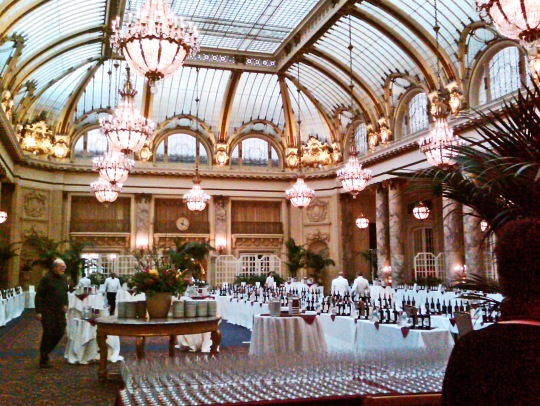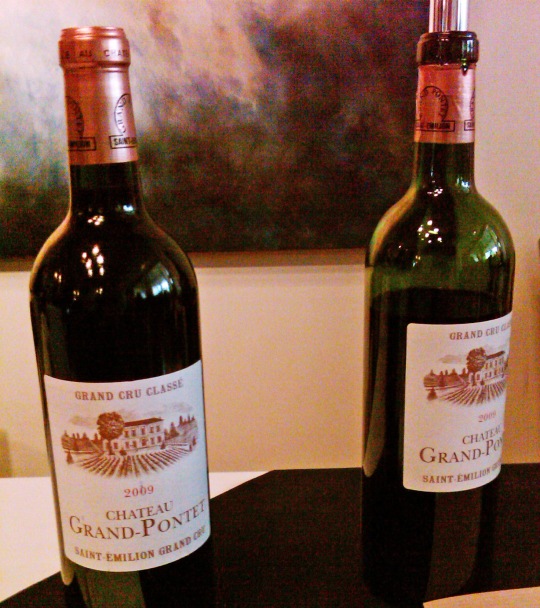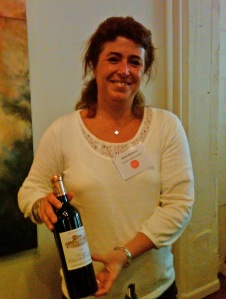Union Des Grands Crus de Bordeaux – a tasting event – 2017
 Union Des Grands Crus de Bordeaux – January 2017 – (with a couple of small digressions)
Union Des Grands Crus de Bordeaux – January 2017 – (with a couple of small digressions)  2017 Rhoda Stewart
2017 Rhoda Stewart
“These are classic wines, lean, structured, balanced, moderate alcohol [13 – 14%), balanced oak (mostly if not all French, from Centre de France.” (Bernard Portet, January 2011, founding winemaker for Clos du Val—est. 1972, Napa Valley, CA)
Held in the ballroom or in a spacious conference room in one of San Francisco’s grand hotels, where stunning chandeliers hang from the vaulted ceilings with their frosted glass skylights, the Grands Crus de Bordeaux tasting event is a wondrous affair.
Elegant even in daylight, the ambience is further enhanced with an enormous bouquet of dazzling red roses at the entrance.

Inside the room are tables covered with crisp white cloths for each of the presenting chateaux, and across the front is a table holding rows of gleaming wine glasses. Situated strategically throughout are enticing stands of cheeses, fruits, and thinly sliced baguettes, all adorned with more flower arrangements.
All done to heighten anticipation for the main event: the wines themselves, and the particular appellation each represents.
The 2011 event was my first experience with the wines of Bordeaux.
Frankly, I was quite overwhelmed. Apart from the Sauternes, which are all sweet white wines, Bordeaux AOCs are predominately red wine appellations. So many wines (upwards to 200); so many soil types (a dozen or more appellations): how to distinguish! So I was delighted to have encountered Monsieur Portet; his words gave me a direction, and some sense of what to expect, and what not to expect. Certainly not the big, luscious, fruity wines of the annual California Zinfandel (ZAP) tasting, which represents most of California’s prime Zinfandel regions. Most of these wines have forward fruit of red or black berries, ripe currants, and other luscious fruits, and carry alcohol levels of 15% or higher; some reek of oak. Rather, expect a less fruity, less luscious wine, leaner, with perhaps more spiciness and earthy fruit tones, and with alcohol levels of from 12.5% to 14%. And definitely NOT smothered in oak!
The primary appellations of Bordeaux are commonly referred to as “Left” and “Right” bank, which refers to the two rivers, the Garonne and Dordogne, running north-east through the Bordeaux peninsula. Left Bank are vineyards to the west of the rivers; Right Bank are vineyards to the east of these rivers. There is also AOC Entre duex Mers, which occupies the land between the rivers.
The Right Bank appellations consist of the AOCs Pomerol, Saint-Emilion, and The Côtes, together making up the region surrounding Libourne, the principal city of the right bank. The wines of the Right Bank AOCs are Merlot-based, and are enhanced and balanced out with varying percentages of Cabernet Franc and Cabernet Sauvignon. The most prestigious are the heady wines of Pomerol and Saint-Emilion. Pomerol, the tiniest Right Bank appellation, is distinguished by its iron-rich clay soil. The Merlot-based wines from this appellation are blended with small percentages of Cabernet Franc, and are renowned for their silky tannins and soft elegance. It is not uncommon that they have some of the Zinfandel fruitiness, notable for flavors of prunes that are typical of Zinfandels made from super-ripe grapes.
There is no classification system for Pomerol. The most prestigious wines of this appellation are Petrus and Le Pin.
The soil of the adjacent and much larger Right Rank appellation of Saint-Emilion is mostly limestone-based, which produces more structured Merlot-based wines that are usually blended with varying percentages of Cabernet Sauvignon, and in some instances, also with a bit of Cab Franc. The limestone-based soil also yields wines of higher acids and robust yet elegant tannins. These wines, while showing less of the fruitiness and more structure than the Pomerols, are nonetheless softer wines than are usually found in Left Bank Bordeaux wines.
Marie Pourguet – Chateau Grand Pontet – St. Emilion Grand Cru Classe

Chateau Grand Pontet – St. Emilion – 2009 – Grand Cru Classe
St. Emilion has a classification system; the highest accorded is Premiere Grand Cru Classé A. Château Cheval Blanc is the most consistent recipient this classification
For those of you whose perceptions of Merlot wines were soured by the raging invective against Merlots leveled by the character Miles in the 2004 Hollywood film Sideways, I recommend a second look, both at the wines and at the film. For while Miles shrieks at his lecherous pal, Jack, as they approach their first bar to mark the beginning of Jack’s week-long pre-wedding sexual debauchery, “I am not drinking Merlot,” yet the prized bottle that he has been hoarding for his 10th wedding anniversary celebration is a bottle of the much-coveted 1961 Château Cheval Blanc, ironically, a Merlot-based wine. The variety (Merlot) is not the problem, as Miles unwittingly reveals in a conversation with his friend Maya a few scenes further on. The problem he has, or thinks he has, with Merlot, is, of course, with himself!
Sadly, there is no mention in that scene, or anywhere else in the film, that Miles realizes that his Premiere Grand Cru Classé A Cheval Blanc is Merlot-based, which acknowledgement might have spared California’s Merlot growers some of the financial losses that Miles’ ignorant tirade against this variety cost them—not to mention greatly enhancing the screenplay! The scene between Maya and Miles at Stephanie’s house (while Stephanie and Jack have retreated to her bedroom) could have been the perfect place for this revelation. When Miles tells Maya that he has this 1961 Cheval Blanc in his tiny “gathering” of wines, I could envision Maya casually remarking how wonderful and long-ageing a Merlot can be under the right circumstances and in the hands of a knowledgeable winemaker.
It is tantalizing to contemplate what Miles’ response to such a comment from Maya might have been. Of course, such an addition to that scene would necessarily change the film into something quite different—and probably much better. As Pulitzer Prize winning Chilean poet Pablo Neruda once wrote in a magnificent little essay called “The Word”: An idea goes through a complete change because one word shifted its place, or because another settled down like a spoiled little thing inside a phrase that was not expecting her but obeys her. (Pablo Neruda: Memoirs, New York: Farrar, Straus and Giroux, 1974, 53.)
So, too, can a single line in a screenplay transform a film.
A further irony occurs at the end of the film when Miles, depressed with the realization that his ex-wife is never coming back and that there will be no10th anniversary celebration with his Cheval Blanc, he finally and surreptitiously drinks this prized wine out of a plastic cup while dining alone on a hamburger in a fast-food roadside restaurant. And, the film suggests, does so with great enjoyment. So a great Merlot can be enjoyed just about anywhere and with any food. So much for Miles’ misplaced outrage, actually one among many, indicating perhaps that the film itself should have been “misplaced” into some obscure corner before it ever made it to the theaters.
But I digress . . . now back to the wonderful world of Grands Crus de Bordeaux!
The Medoc is the largest appellation in the Left Bank. It covers most of the peninsula between the Gironde (the estuary of the Garonne River) and the Atlantic Ocean. It is broken into several sub-appellations whose distinctions are subtle, at least to me, and took me some time to perceive.
In contrast to Right Bank wines, wines of the Medoc are primarily Cabernet Sauvignon-based, and are tempered with the additions of varying percentages of Cab Franc and Merlot as well as with such lesser varieties as Petit Verdot and Malbec. And while you could find a few blends from the Left Bank AOC’s dominated by Merlot, with Cabernet Sauvignon and others among the lesser percentages, the effect overall are nonetheless consistently leaner and more restrained wines than from the Right Bank, with a more distinguished tannin backbone, and with a lingering earthy, spicy component that is instantly recognizable in most Bordeaux reds. These wines usually benefit from a few additional years’ of bottle-ageing in a cool, dark cellar—or a similar environment.
January 2017 Grand Crus de Bordeaux event was my third, and during this event, I felt that I was at last beginning to make some headway. I was detecting distinctions; and I was discovering some favorites among the appellations and within the appellations.
The first such distinctions that I noticed were the spicy, earthy, cocoa-like tannins and flavors in the wines from the warmer gravel-and-clay-based soils found in the AOCs of St. Estèphe and Pauillac, the two northern-most appellations. St. Estèphe is situated on a gravel-based soil next to the Gironde estuary and closest to the Atlantic. Pauillac borders St. Estèphe along the estuary just to the south. These are widely described as powerful reds with a strong Cabernet Sauvignon backbone (upwards to 60%), softened and mellowed with varying percentages of both Merlot and Cabernet Franc.

Chateau Malescot – St. Exupery 2008 – Margaux Grand Cru Classe
These two appellations are the ones I now search out. Not that they are better wines than wines from other of the Bordeaux appellations; rather, it’s just a matter of taste. I am finding the earthy, spicy component that the gravel-and-clay-based fruit imparts to these wines irresistible.
Note: the higher the percentages of Merlot and Cabernet Franc in Left Bank wines, the earlier the wines become approachable; the higher the percentage of Cabernet Sauvignon, the longer the bottle-ageing needed.
Although not immediately on my mind when I approached my first “Grands Crus de Bordeaux” tasting, some few years earlier, in summer of 2001, I made a 3-day sojourn to the Medoc while staying with friends in Saintes, a couple of hours’ drive north of Bordeaux. I had taken the tiny ferry from Royan, across the mouth of the Gironde Estuary, to debark on the very tippy-tip of the Medoc. From there, I followed a “D” level road through the flat terrains of the Medoc and past several of the famous Premier Growth chateaux to the village of Margaux, where I had booked a room in a Relais du Silence. I arrived in time for dinner, and after, I went for an enchanting stroll through the famed vineyards of First Growth Chateau Margaux under a full moon. A memorable evening!
The next morning, my hotel concierge secured an invitation for me to join a small tour group at Chateau Margaux, just a couple hundred meters’ stroll from my hotel along a lane through vineyards. There, a charming professional tour hostess took us through the cellar, including the breathtakingly beautiful white colonnaded chai (the barrel room), and later poured me a full glass of the current release, which, I believe, was the1997. Although it was still well before noon, I savored that wine to the last drop as the hostess and I chatted about wines of the region and also about my book on Zinfandel, which was due for publication by years’ end.
I did not, however, purchase a bottle of the Chateau Margaux, which would have cost me more than my few days’ stay at my small hotel. Instead, I later visited a couple of non-classified chateaux, and upon my return to the village, found a wine store where I purchased a two bottles of Cru Bourgeois recommended by the store sommelier as typical expressions of the Medoc, for about $30 each.
The visit left a vivid impression on me, but not quite what I expected. While the First Growth chateaux are grand establishments with impressive grounds, gardens, and landscaping, and, generally speaking, require appointments made months ahead of one’s visit, their wines are not the only great wines of the region.
Grand Cru wines, wines from grand vineyards, are as capable of producing superb wines as are the great vineyards, those recognized by the five classification “growths” established in mid-18th century. All that differentiates the Grands Crus from the Premiers Crus, actually, is the prestige associated with Premier Cru classifications—and the pricing. The Grands Crus do not, however, lack the quality . . .and price never has been a score.
Union des Grands Crus de Bordeaux, all lovely wines, all structured, balanced, and with long ageing potential (even the Merlot-based!), are available at prices that will leave you with a budget to shop for a dinner menu to accompany. And I still buy Cru Bourgeois whenever presented with the opportunity. And, yes, I do still think about that bewitching glass of 1997 Chateau Margaux, especially when I approach the Grand Cru Classé tables pouring AOC Margaux.
